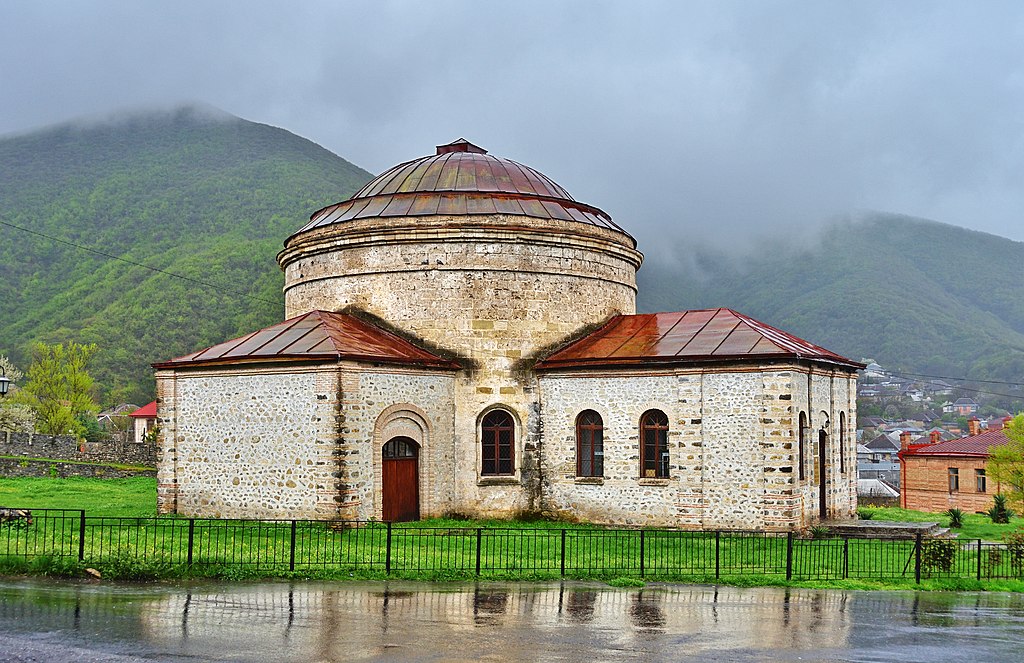The Round Temple

- 12-04-2025, 12:22
- Churches
- Elnur Nəciyev
The Round Temple, also known as the Nukha Church of the Three Saints or the Nukha Holy Church, is a monument of national architectural importance located in the Nukha fortress in the city of Sheki. Currently, the Sheki Museum of Folk Applied Arts is housed inside this building.
About
The central part of the Round Temple (excluding later additions) is topped with a dome, and due to its architectural style and the type of building materials used in its construction, this original structure significantly differs from other buildings in the fortress. For this reason, some researchers associate its history with the period of Azerbaijani Albania. However, in the mid-20th century, when experts examined the Nukha fortress area, they concluded that except for the mosque and the Sheki Khan’s palace, all the buildings within the 6-hectare fortress date to the Russian period. The Round Temple was the only functioning Orthodox church in the present-day city of Sheki from at least 1853 to the early 20th century. Initially, the church building was constructed with finely cut limestone in a circular plan and topped with a dome. Later, additions were made on three sides using river stone and brickwork, expanding the structure into a cross shape (as seen from above). This transformation took place before 1853, as the 1853 plan of the Nukha fortress already depicts the church building with its cross-shaped extensions. It is known that the walls of the Nukha fortress were constructed in such a way that, when viewed from above, they resemble the Arabic script for “Muhammad… (Khan)”.
According to claims, in this formation, the originally circular church building corresponded to the dot of the letter “Nun.” The original circular part of the church differs significantly from other buildings in the fortress in terms of architectural style and building materials. Could it be that the Russians built this structure as a circular church after 1819 and later, before 1853, expanded it into a cross shape? Or did the building already exist in the Nukha fortress before 1819, and the Russians transformed it into a cross-shaped Orthodox church by 1853? There is no mention of a church in the 1819 description of the Nukha fortress. However, the description notes that “other buildings belonging to the rulers of Sheki in the fortress had been occupied by soldiers and Khevsurs,” even after providing information about the structures and their coordinates. This implies that some of the buildings existing at that time may not have been described, thus making it impossible to definitively determine whether the church existed in the Nukha fortress in 1819 based on the description. At present, the former Orthodox temple is registered under the name “Round Temple” and holds the status of a national architectural monument. The Sheki Museum of Folk Applied Arts is currently located inside the former church building.
Claims About the Church Previously Being a Mosque
Location of the old gate of the Sheki Khan’s palace courtyard; view from inside the courtyard; in front of this gate, there was a small 2×2 meter church until the 1990s, and this church was reportedly established in 1828 on the site of the Khan’s private mosque. In the mid-20th century, when experts examined the Nukha fortress area, they concluded that, except for the mosque and the Sheki Khan’s palace, all buildings within the 6-hectare fortress date to the Russian period, although there has been no mosque in the fortress since 1853. It appears that the so-called older mosque was in fact the Church of the Three Saints. The reason for this could be the claims made by the famous Russian traveler Segal and prominent Azerbaijani intellectual Rashid bey Afandiyev in their respective books published in 1902 and 1925. They stated that the Russians converted the Khan’s private mosque into an Orthodox church in 1828. Indeed, in the 1819 description of the Nukha fortress, the Khan’s private prayer room is mentioned as being located below the house of Mahammadhasan Khan, to the left of the entrance gate. However, the small 2×2 meter church in question was located inside Mahammadhasan Khan’s house and remained there until the 1990s. The Church of the Three Saints is at least 50 meters south of that location.
About Priests and Other Church Servants
A source from 1853 mentions that Father Yevstafiy served at the church, and a source from 1861 refers to a priest named Yevstafiy Khuchiyev. Between 1894–1896, the name of the psalm reader was recorded as Gavriil Pechenski. A source from 1905 mentions a priest named David Utiyev (who had served as a priest in the Ingiloy church in 1875 and worked to convert the population of the village of Tasmali to Christianity). David Utiyev is buried on the southwest side of the church.
The Area to the East of the Church Building
During the Russian Empire, the graves of several high-ranking Russian officials who died in Nukha are located in the land east of the church. It is possible that this area served as a cemetery for Russians, where more Russian officials and military personnel may have been buried.




